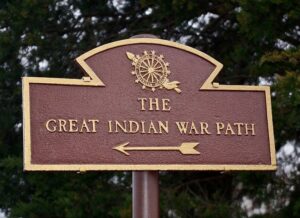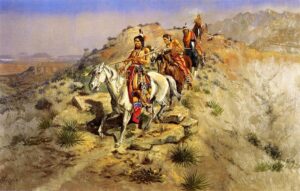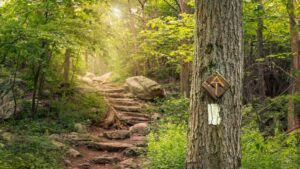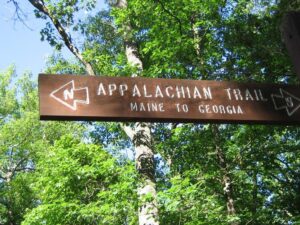
 Knowing that a Native American trail called The Great Indian Warpath, also known as the Great Indian War and Trading Path, or the Seneca Trail, ran through the Great Appalachian Valley and the Appalachian Mountains, makes me wonder how many other major trails started out as or connect to smaller trails that had entirely different uses. The Great Indian Warpath was a network of ancient Indian routes with many branches. It crossed the Appalachian Trail in a number of places across several states, including New York, Pennsylvania, Maryland, West Virginia, Virginia, Tennessee, and Alabama. The Great Indian Warpath was a major north-south route of travel since prehistoric times. Parts of the trail are thought to have been used as many as 2,500 years ago when Indian traders from as far away as the Great Lakes, Rocky Mountains, and Mexico traveled parts of the trail. Various northeastern Indian tribes were known to have traded and made war along the trail, including the Catawba, numerous Algonquian tribes, the Cherokee, and the Iroquois Confederacy, even into more recent history, like the Old West.
Knowing that a Native American trail called The Great Indian Warpath, also known as the Great Indian War and Trading Path, or the Seneca Trail, ran through the Great Appalachian Valley and the Appalachian Mountains, makes me wonder how many other major trails started out as or connect to smaller trails that had entirely different uses. The Great Indian Warpath was a network of ancient Indian routes with many branches. It crossed the Appalachian Trail in a number of places across several states, including New York, Pennsylvania, Maryland, West Virginia, Virginia, Tennessee, and Alabama. The Great Indian Warpath was a major north-south route of travel since prehistoric times. Parts of the trail are thought to have been used as many as 2,500 years ago when Indian traders from as far away as the Great Lakes, Rocky Mountains, and Mexico traveled parts of the trail. Various northeastern Indian tribes were known to have traded and made war along the trail, including the Catawba, numerous Algonquian tribes, the Cherokee, and the Iroquois Confederacy, even into more recent history, like the Old West.
Eventually the Europeans and the White citizen of America began to use the Great Indian Warpath trail, which seems a little bit strange when you think about it. Nevertheless, Europeans, Hernando de Soto and his party used the trail when they crossed the Blue Ridge Mountains in 1540. Then, by the late 1600s, British colonists were using portions of the trail regularly, as they traded with the Indians. The British traders renamed the trail, or gave it a nickname anyway. Their name for the route was created by combining its name among the northeastern Algonquian tribes, “Mishimayagat” or “Great Trail,” with that of the Shawnee and Delaware, “Athawominee” or “Path where they go armed.” The combination translated to the Great Indian Warpath. Later, hunters and settlers traveled the trail to explore Kentucky and Tennessee, which led to the first mass western migration in American history, as settlers followed the Wilderness Road through the Cumberland Gap.
As time went on, the people left the trail at different places to go to find their dreams. Those new trails took on new names, such as the Seneca Trail, the Great Valley Road, Kanawha Trail, Wilderness Road, Catawba Trail, Unicoi Trail, and the Georgia Road. As I think about the well-known trail in the area, the Appalachian Trail, and the number of people who travel that trail every year, it makes me wonder if they have ever noticed the trails 
 that cross it or split off of it. I have hiked along many trails over the years, and I have seen the many trails that have crossed them. Now I wonder what pioneers might have taken those trails on their journeys to wherever it was that they were headed. It’s unlikely that I will ever know the true stores, but it is nice to think about it anyway.
that cross it or split off of it. I have hiked along many trails over the years, and I have seen the many trails that have crossed them. Now I wonder what pioneers might have taken those trails on their journeys to wherever it was that they were headed. It’s unlikely that I will ever know the true stores, but it is nice to think about it anyway.


Leave a Reply